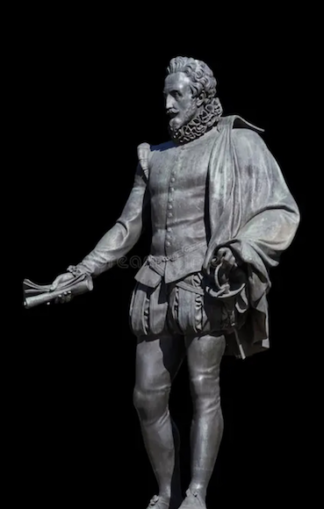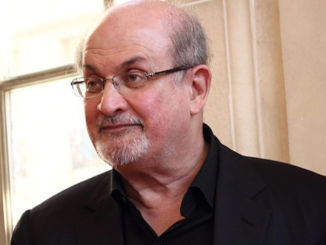Miguel de Cervantes was born in Alcala de Henares on the 29th September 1547, the second son of Rodrigo de Cervantes and Leonor de Cortinas. His father led a precarious and unsettled life as an apothecary surgeon and was from an old family which had latterly become encumbered by debt. In 1552, Rodrigo and an aunt (Maria de Cervantes) faced a lawsuit for non-payment on several candelabra and items of silver which were part bought from a goldsmiths in Vallodid and sold on. From then on the Cervantes family rapidly descended into poverty.
It is known that from an early age Miguel had a love of reading and was at one time enrolled in a Jesuit college.
His family however were constantly on the move to escape creditors and it is not until 1569 that we learn of Miguel again as the star pupil of Juan López de Hoyos, an intellectual erasmist who ran a municipal school in Madrid. In the same year, Miguel had his first poem published about the death of Phillip II’s young queen, Elizabeth de Valois. It was also the year that Miguel fled Spain for Italy after a run-in with the law for what was described as a ‘wounding incident.’
In Italy, Miguel served for a time as a chamberlain in the household of Cardinal Giulio Acquaviva in Rome. However, in 1570 he was joined by his brother Rodrigo and together they enlisted in a naval infantry regiment stationed in Naples. At the time Naples was in the possession of the Spanish crown and was the base for a combined fleet which a year later would be engaged in the battle of Lepanto near Corinth. The Ottoman Empire under Selim II had occupied Cyprus and a confrontation with the forces of Venice, the Papacy and Spain had become inevitable. Miguel and Rodrigo Cervantes sailed on the Marquesa under the command of Don Juan de Austria and engaged the enemy on October 7th.
By all contemporary accounts Miguel de Cervantes had been confined below decks with a fever but insisted on joining the battle where he is said to have fought with great bravery. He was shot twice in the chest and once in the left hand, the use of which he lost for the rest of his life. The battle of Lepanto was however a turning point in the fortunes of the Turks who effectively lost control of the Mediterranean.
Miguel de Cervantes remained in service for another five years as a non-combatant soldier and was entrusted with documents of a sensitive nature. On a journey to Spain with his brother in 1576 his ship was captured by Barbary pirates and he was imprisoned in Algiers, which was the centre of Christian slave traffic for the Muslim world.
The letters he carried magnified his importance in the eyes of his captors and he was held at a premium. He was, despite six escape attempts, to remain captive for another five years until the Spanish monarchy, harassed by the Catholic church, paid ransom for a number of men who were deemed as being of significance. This also ended a constant petitioning from his mother.
On his return to Madrid, Miguel, as many Spaniards did, applied for positions in the Indies and was frequently denied. He did however enter the service of King Filipe II, first as an envoy and later as a royal commissioner for the collection of royal property (tax collector.) He was also responsible as a royal commissioner for the provision of supplies for the Spanish Armada where he was accused of selling off part of the wheat collected from church tithes leading to his imprisonment at the Castro del Rio in Córdoba for two months.
At this time Miguel de Cervantes also began his literary career and over a thirty-year period produced a library of work that goes far beyond the one book that he has become synonymous with. He is now recognised as the father of the modern novel and Don Quixote de La Mancha is second only to the bible in the number of languages it has been translated into. (At the last count 140).
Miguel de Cervantes married Catalina de Salazar, a maiden from Toledo, in December 1584. At the time Miguel was thirty-seven years old and his bride twenty years his junior. The couple lived together until 1587 when Miguel, during the transfer of the relics of Santa Leocadia to Toledo, went absent without leave to begin a journey through Andalusia. the marriage did not produce any children but the couple raised Miguel’s natural daughter.

Bronze Statue of Miguel de Cervantes,
Artur Sharov – Copyright free
Maintaining his employment as a royal commissioner (think Civil Service of today), Miguel was made responsible for tax collection in an area to the east of Seville. At first all went well but he then made the mistake of depositing a large sum of money into a bank which went bankrupt and Miguel became liable for the debt to the Crown and for the second time he was sent to prison. This time he served five months at the Royal Jail of Seville on Calle de Sierpe which is marked today by a blue plaque commemorating Cervantes and rather amusingly the site is now occupied by a Caixabank.
it seems that throughout his life Miguel de Cervantes was never far from controversy. In 1597 he was arrested by the Spanish Inquisition and charged with offences against His Majesty’s Most Catholic Church. The penalty for such a crime was burning at the stake but through his eloquence Cervantes escaped with the lesser sentence of excommunication. In 1604, he returned to his wife and daughter in Esquivias and then in 1605 moved his wife, his daughter, a sister, a niece and a maid to be closer to the royal court, which had moved to Vallodid. While there he fought a duel with a man, who he killed, claiming that the man had sullied his daughter. Yet again Miguel found himself in prison.
Don Quixote de La Mancha
In many ways Don Quixote is the anti-hero we can all relate to, the anti-establishment figure who finds himself up against a hierarchy that he does not believe in. his mind is filled with indignities and he has no time for authority.
What better man then to write the classic masterpiece of Don Quixote de La Mancha, than Cervantes who had endured so much in parallel? it must also be said that were he alive today I have no doubt that Miguel de Cervantes would be a Postalier and a great contributor to boot.
Don Quixote is not an easy read but it contains truths which are still relevant today. It is witty in a sombre but self-depreciating way; the story of an errant knight who swelled by conviction sets out to change not only his own world but the world which has become so far from what Cervantes would want it to be.
There are scholars who try and read into Don Quixote what simply isn’t there. They speak of schizophrenic tendencies and have Cervantes as someone in constant turmoil. the truth however is that Cervantes sees the world not as an establishment but as an independent state of mind. He acknowledges the struggle of man against the Crown, the state or the church and shows us that there is another way to exist without succumbing to the control of those who should never be in power.
He is the man who deals with the indignities of life by living it in his own way.
This leads me to surmise that there is a little bit of Cervantes in all of us and long may it be so.
More than anything Don Quixote teaches us that life is to be challenged, that the passion and discipline of a wilful human spirit is a vital element of leadership. Quixote does not accept reality. He imposes his imagination, his commitment and his joy on it until he produces a world of beauty and of meaning.
***
Miguel de Cervantes died in Madrid on April 22nd, 1616, at the advanced age of 68. From his own testimony, he tells us that he was suffering from hydropsy or uncontrollable thirst which suggests he had cirrhosis of the liver and/or diabetes mellitus, which we know today as type 2 diabetes.
About two weeks before his death Cervantes had entered the Third Order of Franciscans, most likely to show his gratitude for the money that was lent to his family to help secure his rescue from captivity in Algiers.
He requested burial in the church of The Convent of The Barefoot Trinitarians, which was in the neighbourhood of Madrid where he had lived and was interred there the day after his death. At some time, following building work, the body of Cervantes was reburied but the exact location was never documented. In 2015, a communal grave was identified as having the requisite number of bodies for the Cervantes family but DNA testing proved inconclusive in defining where Miguel de Cervantes is actually buried.
It is however somehow fitting that Spain’s greatest novelist continues to trick us all. Perhaps he has moved to the much better world he had always advocated.
© AÑO NUEVO 2023



